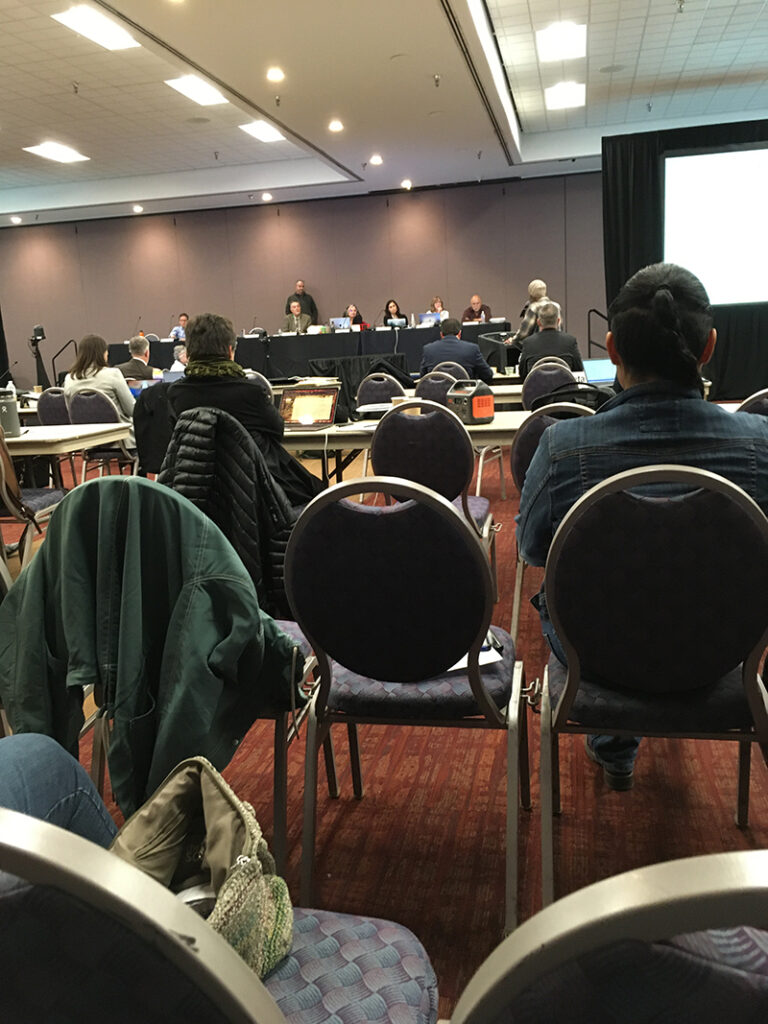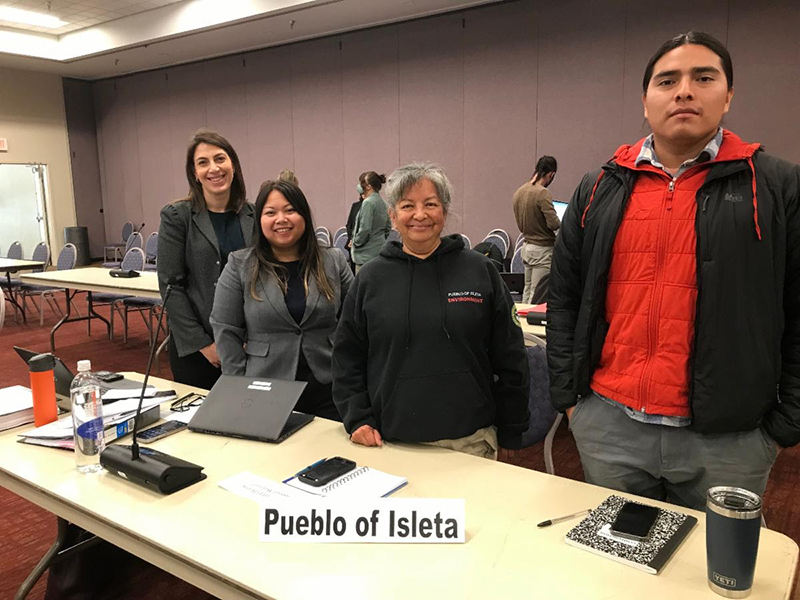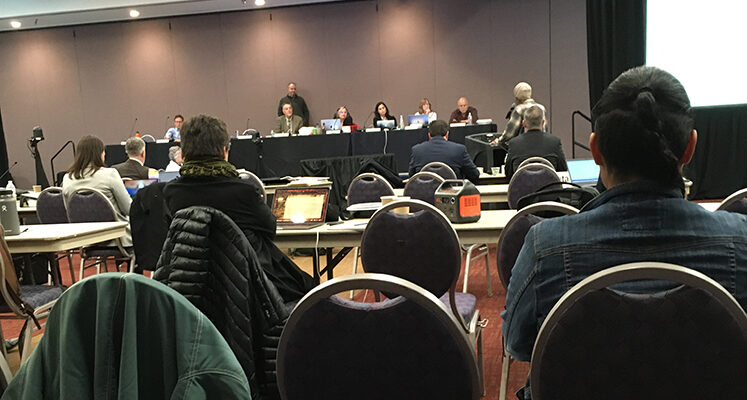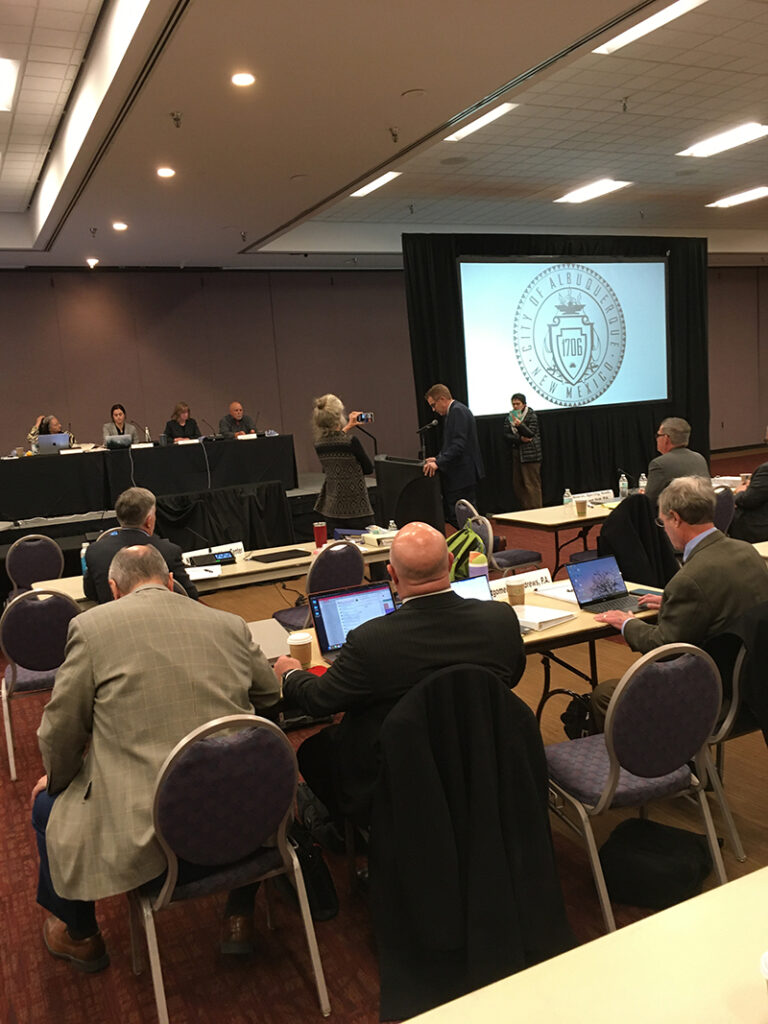
By Kent Paterson
Promoting a tourism mystique, the marketers of Albuquerque, New Mexico, peddle images of clean skies, diverse culture and delicious cuisine. The icons encompass soaring hot air balloons, majestic Sandia Mountain vistas and the ubiquitous chile pepper, red or green. But if current political trends hold, the postcard visitors send grandma might depict more spewing emissions, sickly skies and gagging residents.
At least that’s the implication of recent actions by the Albuquerque City Council that sacked the current members of the joint Albuquerque-Bernalillo County Air Quality Control Board (JAQCB) and blocked a proposed Health, Environment and Equity Impacts rule (HEEI) aimed at protecting low income communities of color in Albuquerque and Bernalillo County from further, disproportionate air pollution impacts, including the cumulative effects of pollution.
Both Minnesota and New Jersey previously adopted similar environmental justice measures.
The rule, which would require review and consideration of environmental and health impacts for air permits, was proposed to the JAQCB last year by the Mountain View Coalition, a citizens’ grouping based in Albuquerque’s South Valley. Members include Mountain View Neighborhood Association, Mountain View Community Action, and Friends of Valle de Oro National Wildlife Refuge.
The HEEI petition is likewise supported by community groups such as Los Jardines Institute and the indigenous Pueblo of Isleta, which is situated on the southern rim of Albuquerque and subjected to pollution from the big city.
A cradle of the modern national environmental justice movement, the predominantly Chicano-Mexicano South Valley and adjoining areas have long struggled against soil, water and air pollution linked to military facilities, industrial plants, big agricultural operations and municipal waste disposal systems.
In 1970, on the first national Earth Day, hundreds of Chicano university students and community members protested odors emanating from Albuquerque’s old sewage treatment plant in the South Barelas neighborhood. In more recent years, residents have protested asphalt plants and other sources of air pollution.
“The time is now. These are basically the things communities have been organizing for,” University of New Mexico (UNM) instructor and veteran activist Manuel Criollo, testified in support of the proposed HEEI regulation at the Albuquerque hearing held by the besieged air board that kicked off December 4, notwithstanding an effort by the Albuquerque City Council to shut it down.
According to the American Lung Association’s 2023 “State of the Air” report, Albuquerque ranked among the 25 worst cities in the nation for ozone pollution. If there was any “good” news in the report, it was metro Albuquerque’s improvement from Number 22 in last year’s rating to Number 24 in this year’s. For 2023, Bernalillo County received a “D” grade for ozone pollution- up from an “F” last year.
(In the Paso del Norte region, the American Lung Association ranked El Paso and Las Cruces as the 14th most polluted place in the U.S. for ozone pollution. Overall, Doña Ana County received “F” grades for ozone pollution and particle pollution.)
“Even one poor air quality day is one too many for our residents at highest risk, such as children, older adults, those who are pregnant and those living with chronic disease,” said JoAnna Strother, the lung association’s senior advocacy director, at the time of the report’s release earlier this year. “That’s why we are calling on lawmakers at the local, state and federal levels to take action to ensure that everyone has clean air to breathe.”
While HEEI advocates and community members turned out for the Albuquerque hearing to advocate for such action, so did a roster of opponents that read like a Who’s Who of the New Mexico power elite.
Think the New Mexico Chamber of Commerce, Kirtland Air Force Base, the United States Air Force, U.S. Department of Energy, the UNM Board of Regents, the New Mexico Mining Association, and the Domenic Law Firm, among others.
In written comments submitted to the JAQCB before the hearing, prominent individuals within New Mexico’s power structure argued that the HEEI threatens jobs, economic development and the military establishment.
The naysayers include Jim Garcia of the Associated Contractors of New Mexico and Sherman McCorkle, former banking executive, venture capitalist, and high tech promoter. Garcia sits on the board of directors of the Albuquerque International Balloon Fiesta, the Albuquerque Hispano Chamber of Commerce, and Santa Fe’s renowned International Folk Art Market.
McCorkle, a director emeritus and Herencia founder of the Albuquerque Hispano Chamber of Commerce, currently serves on the board of the Greater Albuquerque Chamber of Commerce and the chairs the Sandia Science and Technology Development Corporation, a non-profit organization engaged in tech transfer activities between the federal government and private sector.
McCorkle wrote that the air board’s rulemaking jeopardizes “dozens of National Security Missions” involving Department of Defense and Department of Energy agencies; According to McCorkle, the combined economic impact of the local military-industrial complex amounts to 23,000 jobs and $7 plus billion in Bernalillo County; there was some dispute at the hearing whether the agencies were adequately contacted and consulted prior to the hearing.
Leading up to the hearing, the specter of job killers, environmental extremists and even domestic terrorists on the loose was bandied about by some politicians and local media outlets.
In November, Republican City Councilor Dan Lewis, an unsuccessful 2017 mayor candidate who’s also the operations director for fuel oil distributor Davidson Energy, sponsored bills to dismiss current air board members and forestall the pending hearing. Passed by 5-4 votes, the bills were then vetoed by Democratic Mayor Tim Keller.
But on December 4, as the air board hearing was in session, two Democratic city councilors, outgoing District 6 Councilman Pat Davis and Klarissa Peña, flipped earlier votes to join conservative Democrat Louie Sanchez and Republican councilors in overriding the mayor’s vetoes and effectively terminating the current air board while moving to truncate the public hearing in progress.
The measures were passed without the consent of Bernalillo County Commission, which has three seats on the seven member JAQCB. On October 24, the Commission passed a resolution requesting that the city defer proposed legislation on the JAQCB until both participants had a chance for joint review and revision. On December 4, the City Council also approved a joint city-county working group centered on the air board’s future. Again, however, the action was unilateral.
In a December 8 press release, the Commission noted that the JAQCB was established in 1994 through “deliberate and coordinated lawmaking.”
The Albuquerque City Council veto overrides buoyed conservative spirits and pro-fossil fuel forces. The host of a talk show on conservative KKOB Albuquerque radio who told listeners that mere mention of the term environmental justice “sends shivers down your spine,” lauded Democrat Pat Davis for his flip on the JACQCB and HEEI hearing.
Linking the HEEI showdown to broader opposition to the liberty-killing “Green Amendment,” the host said, “Hopefully, this can be a jumping off point for other things going on.”
Air Board Members Resist an Immediate Shut Down
Not surprisingly, Councilor Lewis applauded the veto overrides, declaring that “Essentially, the (HEEI) hearing must cease according to the law.” Lewis’s statement was initially reported as fact by major Albuquerque media, including the Albuquerque Journal, which proclaimed (the hearing) “was almost over before it began.”
Yet after spending months preparing a hearing to ensure public participation in life and death matters, air board members were in no mood to quit.
Despite the city council’s terminator votes, the board forged ahead with its proceedings anyway, accepting sworn testimony both in person and via Zoom.
Illustrating a charged atmosphere surrounding the hearing, in-person attendees were first forced to pass through a metal detector and/or undergo pat downs before entering the hearing room at the downtown Albuquerque Convention Center.
Asked by this reporter about Lewis’ contention that the hearing couldn’t legally proceed, JAQCB Chairperson Maxine Paul said, “We’re doing our job.
On the second evening, tension permeated the room when Councilor Lewis arrived accompanied by City Council staffer Kevin Morrow. Given the floor, Lewis reminded the board of the City Council’s votes and read his cease and desist letter.
Pushing back, JAQCB attorney Antoinette Sedillo-Lopez told Lewis and Morrow that the board hadn’t even been officially notified of the council’s actions, and wasn’t even aware of an effective date of enactment. “I’ll see you in court,” Sedillo-Lopez told Morrow, to the applause of the audience.
Accordingly, Sedillo-Lopez filed for a temporary restraining order from the Second Judicial District Court, which apparently floated about in legal limbo as the hearing proceeded with more testimony from all sides.
Before leaving the hearing, Lewis was taken to task by two air board members for his recent press releases that variously labeled the board “rogue” and stacked with environmental “extremists.”
Appointed to a three-year term last April, Dr. Joseph Galewsky, professor of atmospheric sciences at UNM, asked why he was being shown the exit door so soon. Lewis replied that Galewsky could reapply to the new board that will be created.
Kitty Richards, environmental health specialist and co-founder of the New Mexico Public Health Institute, excoriated Lewis for his actions and words. “I’m very deeply, deeply disturbed how you’ve divided the community. I fear for my family,” Richards said. “I feel like I’m a poll worker in Georgia.”
Lewis danced around Richard’s invitation for an apology and her question of whether he believed she was an environmental extremist. “I believe members of the board are,” Lewis replied.
For nearly three years, Richards and other board members have been under attack of lawyers representing business interests who demanded their recusal (which has happened on different occasions) or disqualification because of alleged conflicts of interest stemming from prior ties to the non-profit New Mexico Environmental Law Center, the attorneys for the HEEI petitioners, or simply because of their professional endeavors.
A short glance at Richards’ lengthy resume reveals why certain interests might not want her voice in policy matters. Since the 1980s, Richards has worked with multiple agencies on New Mexico and U.S.-Mexico border health and environmental and health matters.
Regarding the air quality in Albuquerque’s San Jose neighborhood, one of the areas where the HEEI could benefit public health, Richards once wrote there were a “disproportionate number of air pollution sources in the San Jose neighborhood, compared to Bernalillo County as a whole.”
The media offensive against JAQCB members escalated during the hearing when the editorial board of the increasingly news thin Albuquerque Journal accused the JAQCB of “insubordination.” Parroting the charges of opponents that out-of-control environmental extremists were wreaking havoc, the Journal displayed some rhetorical adventurism of its own when it cited the air board’s actions as an example of a “bureaucratic deep state.” For good measure, the editorialists tossed Cold War fears into the mix.
“So instead of being able to shoot down a North Korean missile, we could be left waiting for a local air permit to be issued by a bunch of overzealous environmental extremists,” the Journal bellowed.
THE PUBLIC SPEAKS

To the apparent chagrin of the Journal’s editors, the Albuquerque hearing forged ahead the week of December 4-8, giving both opponents and proponents of the HEEI a chance to state their case. During the public comment sessions, more than 100 community members spoke out, nearly all of them in favor of the HEEI.
Describing herself as a low-income grandmother on a fixed income who suffers from particulate pollution, Barbara Wisoff contended that a lack of enforcement characterizes construction sites that don’t properly contain dust.
“I don’t think that corporations should be allowed to monitor themselves,” Wisoff opined. “I feel that they are inheriting this mess (to) generations by allowing business to run rough shed over community concerns.”
Members of the activist Youth United for Climate Crisis Action (YUCCA) linked the HEEI issue to the climate emergency and environmental crises engulfing the planet.
YUCCA member Annette Lopez told air board members that family members suffer asthma and exposures to ecological disasters like last summer’s massive fire at an Albuquerque area plastics recycling facility that sent thick, black clouds tumbling into a lower-income section of the city for hours on a Sunday afternoon.
Passage of the HEEI, Lopez asserted, would be a “monumental step” in addressing the ecological crisis. The world has “less than 7 years to act on our climate and environment before we reach the point of no return,” she warned.
Heaven Lucero, environmental technician for the Pueblo of Isleta Environment Department, testified that residents awaken or retire to dirty skies during mornings and afternoons when the sun is at certain angles. According to Lucero, “We get calls frequently from community members,” asking, “What is in the air north of the Pueblo? Can we go out?”
Cancer is rife on the reservation, and the Pueblo will soon install monitoring devices to measure air quality, Lucero added.
Some criticized the opposition of UNM, a school which prides itself as a Hispanic-serving institution and as a faithful adherent to the Diversity, Equity and Inclusion principle.
But UNM is also a big business mindful of its bottom line, and an enterprise moving forward with a massive health services complex expansion. Additionally, New Mexico’s flagship of higher education is steaming ahead with a sprawling Tax Increment Development District (TIDD) near the campus in order to lure new privately-owned businesses like the California-based burger and fry chain In-N-Out, which according to UNM, will roll out their grills in the new TIDD-in 2027.
In a TIDD, tax revenues generated over a defined period of time are spent exclusively on infrastructure needs within the development district, as opposed to going for general municipal needs. Essentially, a TIDD works as a public subsidy for private business.
As the HEEI hearing progressed, Councilman Dan Lewis remained a hot topic. A woman activist who was singled out in one of the politician’s press releases charged that family lives were “put in jeopardy because of the words of Dan Lewis.”
Albuquerque City Councilor Tammy Fiebelkorn, who along with the outgoing Ike Benton is one of two city council members standing firm against Dan Lewis’ bills, said she was “appalled” at the actions of fellow councilors and thanked the JAQCB for not caving in to “bullies.”
Alarmed by the developments, military veteran Harold Pope Jr., New Mexico’s first elected African-American member of the State Senate, came to the hearing. The senator implored the state, county and city governments to work together on the issue, insisting that “getting rid of a board” wasn’t the answer and that talk of “extremists and eco-extremists” should go out the door. Words have consequences, he said.
As the hearing entered a second week, the legal, political and environmental fallout from December’s HEEI/environmental justice showdown in Albuquerque was likely to spread. Stay tuned.



Saludos Kent.
Good article.
Ike B
Thank you for writing an article and clarifying what actually happened . Dan Lewis overstepped and the city council needs to work for all the people . Our air quality just like our water needs to be protected
Not able to comment by Zoom during the public comment period to the Board per technical problems I submit part here…
The current Albuquerque Bernalillo County Air Quality Control Board is doing its job as appointed by elected officials. Many Officials have apparently chosen to forget that the appointees’ job is to protect air quality.
Formerly, business interests were the priority of Air Board Members, contributing to the current Environmental Justices(EJ) issues in the Mountain View/San Jose neighborhoods, who have endured the vast majority of metro- hazardous emissions many years. EJ is real, not ‘so-called’.
Speculation that clean air kills jobs is simply political rhetoric or vested interests. Quite the opposite, air pollution kills people particularly in concentration with cumulative toxic poll,utants. Clean businesses look for clean environments that is what a healthy forward- looking community has without burdening a single area.
Councilors Benton and Fiebelkorn stood for the Air Board’s purpose of air quality first as well as the current Board Members that will serve the ABQ metro and all of us well into the future. Yes, the Board must finish the job they agreed to do.
It’s coming here, too. The BOTA expansion project by the GSA is rolling along and will increase truck traffic (idling diesels) in El Paso’s poorest neighborhoods. https://www.gsa.gov/about-us/gsa-regions/region-7-greater-southwest/buildings-and-facilities/texas/bridge-of-the-americas-land-port-of-entry
BOTA is almost 60 years old and has reached the end of its service life, like a lot of public infrastructure. I am concerned, too, that its expansion could be a way to remove the Colliseum. Gee, you don’t suppose there are people in the local power elite who would like nothing more than to see that? GSA has said that is an option but not a priority in the current scheme.
You can educate youself on this topic at two events tomorrow. At 4PM there will be a press conference at which various affected neighborhood groups will discuss the impact of the BOTA expansion on their lives. I will be there prepresenting the Sierra Club that stands with these associations and would like to see BOTA free of truck traffic in the future, with it being directed to the Fabens POE.
The presser will be held at Hilos De Plata Senior Center, 4451 Delta Drive, El Paso Texas, 79905.
At 6PM in the same location, the GSA will host a public scoping meeting to comply with the National Environmental Protection Act (NEPA). So you can hear from the horse’s mouth what this thing looks like and let them know your thoughts. Mostly, I think they have this one cooked and booked and will do what they will do, NEPA being a formality. Perhaps you could let your Congressional Rep, Hon. Veronica Escobar, know why you think more diesel fumes are not a good idea for poor neighborhoods. I will.
Good and essential reporting, thank you!
Great piece, Kent, I hope to see much more on this issue. You shed light in some dark corners.